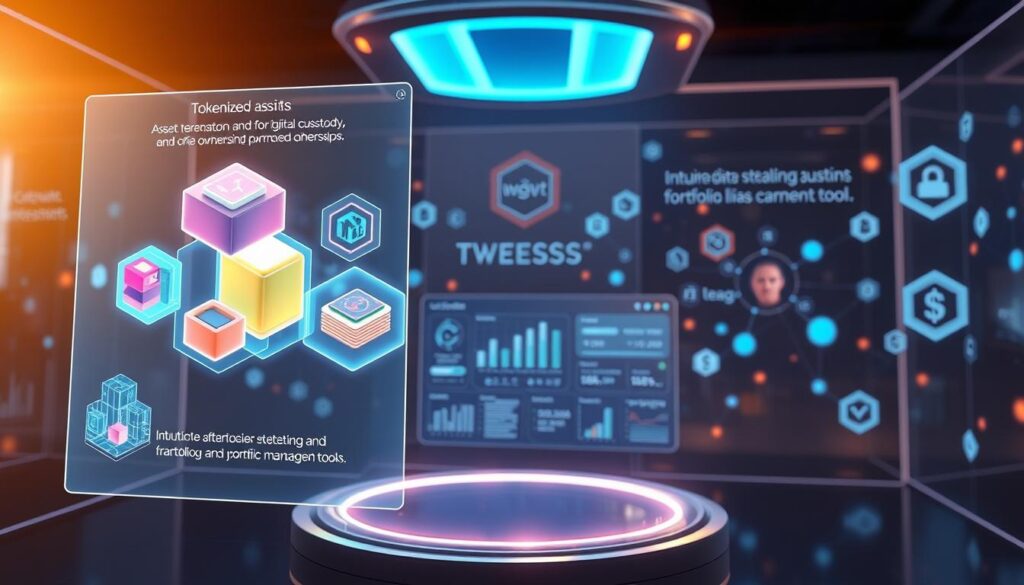Now Reading: AI Tokenization Asset Management Platform Explained
- 01
AI Tokenization Asset Management Platform Explained
AI Tokenization Asset Management Platform Explained

The financial world is undergoing a remarkable transformation. Traditional methods of handling investments are being reshaped by cutting-edge technology. This guide explores how modern solutions are changing how people and institutions handle their holdings.
These innovative systems combine artificial intelligence with blockchain technology. They create digital representations of physical items and intangible holdings. This process makes ownership more accessible and transparent than ever before.
Instead of complex paperwork and limited access, investors now have new opportunities. Real estate, artwork, and commodities can be divided into smaller, tradeable units. This approach opens doors for more people to participate in markets previously reserved for large institutions.
The entire ecosystem includes security measures, compliance frameworks, and user-friendly interfaces. These elements work together to ensure a smooth experience. The result is greater liquidity, reduced costs, and enhanced visibility into investment performance.
Key Takeaways
- Modern investment platforms combine artificial intelligence with blockchain technology
- Digital tokens represent ownership in real-world items like property and art
- These systems make investment opportunities more accessible to everyone
- Traditional methods are being replaced by more efficient digital solutions
- Enhanced transparency and liquidity are key benefits of this approach
- The technology covers security, compliance, and user experience elements
- Both individuals and institutions can benefit from these innovative tools
Introduction to the New Era of Asset Management
Traditional approaches to portfolio oversight face unprecedented challenges. The digital revolution is reshaping how people handle their financial holdings.
Understanding the shift from traditional to digital solutions
Conventional wealth administration relied heavily on intermediaries. Brokers, custodians, and banks created complex layers that increased costs. These traditional methods often involved extensive paperwork and delayed settlements.
Digital solutions eliminate many of these barriers. They create transparent records of ownership through innovative technology. This shift brings greater efficiency to the entire investment process.
Why tokenization is disrupting the market
This innovative approach breaks down high-value holdings into smaller units. It allows people with limited capital to participate in opportunities once reserved for wealthy individuals. The market disruption is creating more inclusive financial ecosystems.
Investors can now diversify across various classes without substantial commitments. Geographical barriers that restricted cross-border participation are disappearing. This democratization of wealth building represents a fundamental change in investment access.
What is AI Tokenization Asset Management Platform?
Digital innovation is creating new pathways for investment participation. These sophisticated systems transform how people interact with various holdings through advanced technological integration.
The conversion method follows a structured approach that begins with careful evaluation. Suitable items are identified based on market demand and regulatory considerations. This initial screening ensures only viable opportunities proceed to the next stage.
Defining tokenization and its core components
Valuation represents the second critical phase. Sophisticated algorithms analyze extensive market data to determine fair pricing. This analytical process considers historical performance, comparable sales, and current trends.
Digital unit creation follows the valuation stage. Each share represents a specific fractional stake in the underlying holding. The division process enables broader participation through smaller investment amounts.
Distributed ledger integration provides the foundation for security and transparency. Automated contracts handle compliance verification and transaction execution. This technological backbone ensures immutable record-keeping and smooth operations.
Ongoing oversight maintains system integrity through continuous monitoring. Market conditions, risk factors, and regulatory requirements receive constant attention. This comprehensive approach supports secondary market activity and investor protection.
| Feature | Traditional Approach | Tokenized Solution |
|---|---|---|
| Ownership Structure | Whole units only | Fractional shares available |
| Market Access | Limited to qualified investors | Broader participation opportunities |
| Transaction Speed | Days or weeks for settlement | Near-instantaneous processing |
| Record Keeping | Paper-based or centralized digital | Distributed ledger technology |
| Transparency Level | Limited visibility for investors | Comprehensive tracking available |
Core system elements include user interfaces, compliance modules, and analytical engines. These components work together to create a seamless experience for all participants. The result is greater accessibility and enhanced efficiency throughout the investment lifecycle.
Comparing AI Tokenization with Traditional Asset Management Methods
Investment strategies are evolving at an unprecedented pace, creating clear distinctions between old and new approaches. The digital revolution brings measurable improvements across multiple dimensions.

Differences in liquidity, transparency, and accessibility
Traditional systems often struggle with limited market movement. High-value holdings can take months to sell. Digital solutions enable continuous trading on global exchanges.
Transparency improves dramatically with distributed ledger technology. Investors gain clear visibility into transaction histories. This creates trust through verifiable records.
Access barriers disappear with modern approaches. Geographic restrictions and high minimums no longer limit participation. More people can build diversified portfolios.
Impact on fractional ownership and investment democratization
Fractional shares break down large investments into affordable units. A commercial property can divide into thousands of tokens. Middle-income participants gain entry to premium markets.
Democratization occurs when gatekeepers and costs reduce. Diverse investor populations benefit from expanded opportunities. Portfolio building becomes more inclusive worldwide.
| Feature | Conventional Methods | Digital Token Approach |
|---|---|---|
| Market Hours | Business days only | 24/7 global trading |
| Settlement Time | Days or weeks | Minutes |
| Minimum Investment | Often $10,000+ | As low as $100 |
| Fee Structure | 5-10% typically | Often under 1% |
| Record Verification | Centralized databases | Immutable distributed ledger |
The comparison shows significant advantages for modern investment systems. Efficiency gains and cost reductions benefit all participants. This evolution represents meaningful progress in wealth administration.
Key Features and Benefits of Tokenized Assets
Digital ownership models are revolutionizing how people interact with valuable holdings. These innovative approaches provide distinct advantages that transform investment experiences.
Fractional ownership and increased liquidity
Fractional ownership stands as a groundbreaking feature of modern investment systems. High-value items can divide into numerous digital units called tokens.
This approach makes premium markets accessible to everyday investors. People can own small portions of expensive properties or rare collectibles.
Increased liquidity transforms traditionally hard-to-sell holdings. Digital tokens trade on global markets around the clock. This creates continuous trading opportunities for participants.

Lower transaction costs and enhanced transparency
Automated processes significantly reduce operational expenses. Smart contracts handle many administrative tasks without human intervention.
Lower costs benefit both issuers and investors. The savings come from eliminating middlemen and streamlining operations.
Enhanced transparency builds trust through verifiable records. Every ownership change appears on distributed ledgers. This creates immutable audit trails for all transactions.
| Feature | Traditional Assets | Tokenized Assets |
|---|---|---|
| Minimum Investment | Typically $10,000+ | As low as $100 |
| Trading Hours | Business days only | 24/7 global access |
| Settlement Time | Days or weeks | Near-instantaneous |
| Fee Structure | 5-10% typically | Often under 1% |
| Record Verification | Centralized systems | Distributed ledger technology |
The combination of these features creates superior efficiency and broader accessibility. Investors gain more control over their financial future through these advanced systems.
Blockchain Technology and Smart Contracts in Tokenization
Advanced distributed networks provide the backbone for contemporary investment solutions. These systems create trust through transparent record-keeping and automated execution.

The foundation relies on sophisticated blockchain technology that ensures data integrity across multiple locations. This approach eliminates single points of failure while maintaining comprehensive audit trails.
Role of immutable ledgers and automated transactions
Immutable ledgers create permanent records that cannot be altered after creation. Every ownership change and transfer receives timestamped verification. This builds investor confidence through transparent history tracking.
Smart contracts automate complex processes without manual intervention. These self-executing programs handle compliance checks and payment distributions automatically. The result is faster settlement and reduced operational costs.
Automated transactions through this technology eliminate traditional delays. What once took days now completes in minutes. This efficiency benefits both issuers and investors significantly.
The combination of blockchain infrastructure and smart contracts creates robust systems. Multiple networks offer different characteristics for various needs. This flexibility supports diverse investment requirements effectively.
The Role of Artificial Intelligence in Streamlining Asset Valuation
The accuracy and speed of property assessment have reached new heights through advanced analytical technologies. These systems process enormous amounts of financial information to deliver precise valuations.
Sophisticated algorithms examine multiple factors simultaneously. They consider current economic conditions and historical performance patterns.
Automation of valuation and market trend analysis
Machine learning models automate the entire appraisal process. They continuously analyze market movements and comparable transactions.
Real-time data processing enables instant updates to investment values. This ensures prices reflect current market realities rather than outdated estimates.

Trend analysis capabilities identify emerging opportunities across various sectors. The tools examine trading volumes and economic indicators.
Risk assessment and compliance monitoring through AI
Risk evaluation systems assess multiple factors automatically. They analyze volatility patterns and regulatory changes.
Compliance monitoring ensures all activities follow legal requirements. The process automatically flags suspicious transactions for review.
These intelligent systems create comprehensive risk profiles. They provide investors with clear insights into potential challenges.
The combination of automated valuation and risk management delivers significant efficiency gains. Investors benefit from more accurate assessments and better protection.
Diverse Asset Classes Powered by Tokenization
Modern financial systems now encompass a wider range of valuable items than ever before. This expansion brings new opportunities for portfolio diversification across various sectors.
Real estate tokenization and its benefits
Real estate represents one of the most promising areas for digital transformation. Properties worth millions can divide into affordable digital shares.
This approach eliminates traditional barriers like high minimum investments. Investors gain access to premium commercial and residential properties.
Fractional ownership through estate tokenization creates liquid markets for traditionally illiquid holdings. Property developers benefit from new capital-raising options.
Art, collectibles, and other unconventional assets
The art world experiences similar transformation through digital shares. Valuable paintings and sculptures become accessible to everyday collectors.
Rare wines, classic cars, and unique collectibles also benefit from this approach. Multiple investors can share ownership of items previously reserved for wealthy individuals.
Commodities like gold and agricultural products join this movement. Digital representations eliminate storage and verification challenges.
Even intellectual property and royalty streams can undergo this process. The range of available tokenized assets continues to expand dramatically.
Leading Tokenization Platforms in the Market
Investors today can choose from multiple specialized systems designed for creating and managing digital securities. These technological offerings provide distinct approaches to handling various investment types.
Each solution brings unique strengths to the table. Some focus on regulatory compliance while others emphasize user experience.
Insights into Polymath, Securitize, and Harbor
Polymath stands out with its ST20 standard for security creation. This approach ensures regulatory adherence while maintaining simplicity for users.
The ecosystem includes partnerships with legal and financial institutions. This provides comprehensive support for equity transformation.
Securitize offers complete offerings for security token operations. Their tools cover compliance, investor relations, and secondary market access.
Harbor specializes in private securities with real estate focus. Built-in verification tools streamline the entire investment lifecycle.
| Provider | Primary Focus | Key Features | Target Market |
|---|---|---|---|
| Polymath | Security token standards | ST20 compliance, legal partnerships | Equity and REITs |
| Securitize | Full-stack solutions | Secondary market access, multi-network support | Diverse security offerings |
| Harbor | Private securities | Real estate specialization, investor verification | Accredited investors |
These technological innovators continue evolving their offerings. The market benefits from their specialized approaches to digital investment solutions.
Security, Compliance, and Regulatory Considerations
Protecting investor interests demands sophisticated security protocols and unwavering commitment to regulatory standards. These systems must navigate complex legal landscapes while ensuring complete protection.
KYC/AML processes and regulatory adherence
Know Your Customer verification represents a critical first step. This process collects identification documents and assesses investor suitability.
Anti-money laundering monitoring occurs continuously throughout the investment lifecycle. Suspicious transaction patterns trigger automatic alerts for review.
Regulatory compliance varies across different jurisdictions. Each region maintains unique requirements for digital securities.
Blockchain security and data integrity
Distributed ledger technology provides inherent security advantages. The decentralized nature eliminates single points of failure.
Data integrity remains protected through cryptographic hashing and consensus mechanisms. Multiple network nodes must validate each transaction.
This creates tamper-proof records that enhance trust and accountability. The security framework ensures investor confidence in the entire process.
Future Trends and Innovations in AI Tokenization
The horizon of digital finance reveals exciting new possibilities for investment structures. Emerging systems combine multiple advanced technologies to create more efficient markets.
These innovations will transform how people participate in various sectors. The pace of change continues to accelerate globally.
Emerging technologies and market forecasts
Cross-chain interoperability represents a major breakthrough. This allows digital shares to move between different networks seamlessly.
Such flexibility eliminates current fragmentation issues. It creates unified global trading environments.
Enhanced analytical tools will provide sophisticated predictive capabilities. Investors gain access to institutional-grade risk assessment systems.
Market forecasts indicate tremendous growth potential. Trillions in real-world assets may undergo this transformation within a decade.
New categories like carbon credits and water rights join traditional offerings. This expansion aligns with sustainable investment trends.
| Innovation Area | Current Status | Future Development | Market Impact |
|---|---|---|---|
| DeFi Integration | Limited experimentation | Full collateralization options | Blended traditional/decentralized finance |
| Regulatory Frameworks | Evolving standards | Specialized digital asset licensing | Mainstream institutional participation |
| Technology Stack | Basic functionality | Quantum-resistant security layers | Enhanced privacy and scalability |
| Asset Classes | Real estate focus | Environmental and natural resources | Broader diversification opportunities |
The convergence with IoT sensors and virtual reality will create immersive experiences. These tools provide real-time monitoring of physical holdings.
Regulatory innovation will accelerate as governments recognize the benefits. This development supports safer real-world assets integration into digital markets.
These advancements promise more accessible and efficient investment landscapes. The future looks bright for this transformative approach.
Conclusion
Contemporary investment methodologies are breaking down traditional barriers to market participation. This digital transformation represents a fundamental shift in how wealth is created and distributed globally.
The comparison between conventional approaches and modern solutions reveals significant advantages. Enhanced liquidity, reduced costs, and greater transparency benefit all market participants. These innovations make premium opportunities accessible to diverse investors.
Real estate and other valuable holdings undergo remarkable transformation through digital tokenization. Specialized platforms provide the infrastructure needed for mainstream adoption. Security measures and regulatory compliance ensure investor protection throughout the process.
The future promises continued evolution as technology unlocks the full potential of this approach. More asset classes will join this movement, creating unprecedented investment pathways. This represents meaningful progress toward more inclusive financial ecosystems.
FAQ
What exactly is an AI tokenization asset management platform?
It is a digital ecosystem that uses artificial intelligence to convert physical or financial holdings into digital tokens on a blockchain. This process enhances trading, fractional ownership, and oversight of real-world assets like real estate or art.
How does tokenization improve liquidity for traditionally illiquid assets?
By dividing a high-value holding into smaller digital tokens, these systems unlock market access. Investors can buy and sell fractions easily on secondary markets, boosting overall trading volume and efficiency.
What role do smart contracts play in this process?
Smart contracts automate key steps, such as distributing dividends or enforcing ownership rules. They execute transactions automatically when conditions are met, increasing transparency and reducing manual oversight.
Are tokenized investments secure and compliant with regulations?
Leading solutions prioritize security and regulatory compliance. They integrate Know Your Customer (KYC) checks, use immutable blockchain ledgers for data integrity, and adhere to securities laws to protect all participants.
Which real-world assets can be tokenized using these platforms?
A wide range of holdings can be digitized. This includes commercial property, fine art, collectibles, and even intellectual property, opening up new investment avenues for a broader audience.
How does artificial intelligence contribute to asset valuation?
AI algorithms analyze market data, trends, and comparable sales to provide real-time, accurate valuations. This automation supports better risk assessment and helps in monitoring regulatory requirements.
What are some prominent companies offering these services?
Established providers in this space include Polymath, Securitize, and Harbor. Each offers specialized tools for creating, managing, and trading digital securities with a focus on compliance and user experience.















